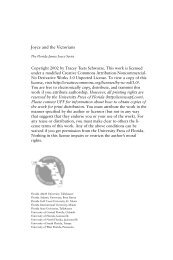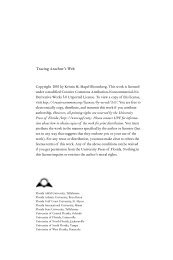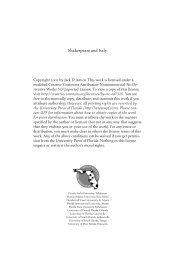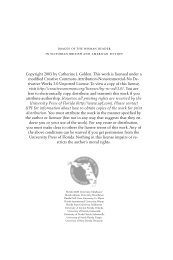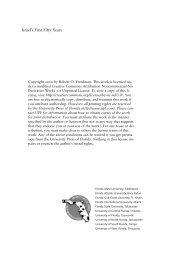Bernard Shaw's Remarkable Religion: A Faith That Fits the Facts
Bernard Shaw's Remarkable Religion: A Faith That Fits the Facts
Bernard Shaw's Remarkable Religion: A Faith That Fits the Facts
You also want an ePaper? Increase the reach of your titles
YUMPU automatically turns print PDFs into web optimized ePapers that Google loves.
A Playwright’s Progress 87<br />
Shaw is not accusing Pinero, who was unquestionably talented at painting<br />
what he saw, of being an unskilled observer, and <strong>the</strong> fact that his audiences<br />
generally wore lenses of <strong>the</strong> same moral tint as his meant that his reputation<br />
for faithful portrayal was—as far as it went—perfectly justified. Shaw<br />
admits this: “Mr. Pinero . . . is . . . simply an adroit describer of people as <strong>the</strong><br />
ordinary man sees and judges <strong>the</strong>m” (272). The reason Shaw’s characters<br />
still seem vivid and alive after nearly one hundred years and Pinero’s (by<br />
and large) do not is simply because we have changed <strong>the</strong> color of our lenses<br />
(not, alas, that we have dispensed with <strong>the</strong>m). The advantage of portraying<br />
characters from <strong>the</strong>ir own point of view is not that you prevent <strong>the</strong> audience<br />
from seeing <strong>the</strong>m through spectacles of conventional ideas, for you<br />
cannot stop <strong>the</strong>m. You might provide details that will be difficult to fit into<br />
preconceived notions and even provoke some change in attitudes. You can<br />
certainly avoid flattering conventional prejudices. Ultimately people will<br />
observe your characters through <strong>the</strong> same moral eyeglasses as <strong>the</strong>y do real<br />
people but only if you have presented <strong>the</strong>m as real people. If you have<br />
designed <strong>the</strong>m for a particular style of lens, <strong>the</strong>y will appear false when <strong>the</strong><br />
style changes, even though for <strong>the</strong> moment <strong>the</strong> average person will declare<br />
<strong>the</strong>m to be more accurate depictions than those painted without distortions<br />
at all.<br />
To portray a character from her own point of view is not <strong>the</strong> same as to<br />
show her in <strong>the</strong> kind of flattering setting and dressed in <strong>the</strong> self-justifying<br />
moral garments she might herself have chosen for a formal portrait. You<br />
must observe her carefully and paint what you see ra<strong>the</strong>r than how you<br />
feel about what you see. You must also ask why she does what she does but<br />
must never couch <strong>the</strong> answer in moralistic terms. The answer to “Why did<br />
she leave her husband?” cannot be “Because she is a faithless wretch” (or,<br />
for that matter, “fearless idealist”). The scientific realist objects that to<br />
delve into personal motivation is to go beyond what can actually be observed<br />
onto <strong>the</strong> subjective grounds of interpretation; Shaw answers that<br />
no artist can avoid interpreting according to his understanding and assumptions<br />
and that it cannot be helped in any case, for <strong>the</strong> spring of human<br />
action lies in human motivation.<br />
Realism and <strong>the</strong> Higher Type<br />
Shaw’s concern with motivation explains ano<strong>the</strong>r difference between him<br />
and <strong>the</strong> realists of Zola’s school. Becker claims that realism “seems to contain<br />
a kind of implicit Benthamite assumption that <strong>the</strong> life lived by <strong>the</strong><br />
greatest number is somehow <strong>the</strong> most real” and quotes Maupassant as



